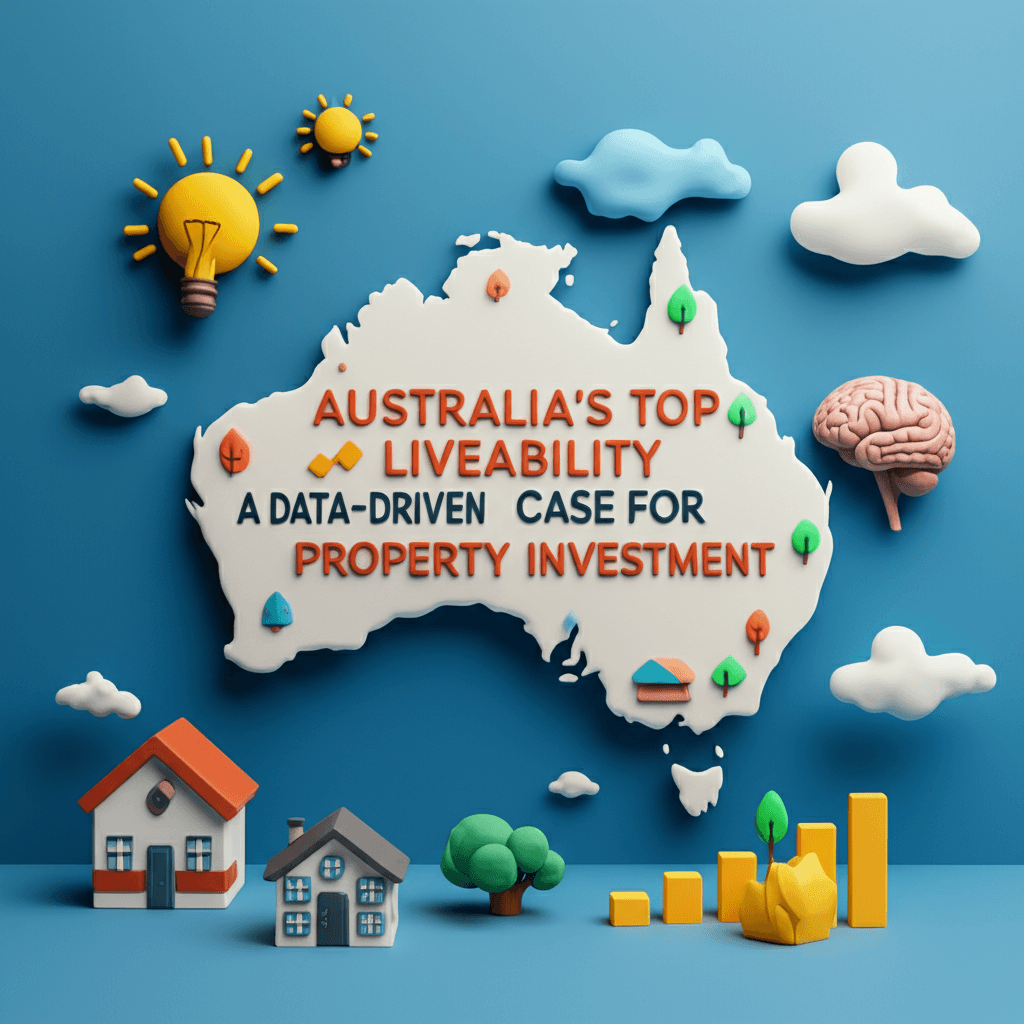Australia's Top Liveability Ranking: A Data-Driven Case for Property Investment
Discover how the 2024 Global Liveability Index reveals the long-term stability and growth potential of the Australian real estate market.

Navigating the Australian property market in mid-2025 can feel daunting. With persistent headlines about rising interest rates and affordability challenges, it's easy to question the long-term viability of real estate investment. However, seasoned investors know that the key to success lies in looking beyond the short-term noise and focusing on fundamental drivers of value. One of the most powerful, yet often overlooked, indicators is global liveability.
This article delves into the Economist Intelligence Unit's (EIU) 2024 Global Liveability Index, revealing why Australia's consistent high ranking isn't just a matter of national pride—it's a critical data point that underpins the stability and enduring appeal of its property market. We'll explore how this data provides a strong case for continued investment and how you can leverage this knowledge to make smarter, more confident decisions.
Understanding the 2024 Global Liveability Index
The Global Liveability Index, compiled annually by the EIU, is a respected international benchmark that assesses living conditions in 173 cities worldwide. It's not a patriotic Australian study; it's an objective analysis from a London-based organisation, which adds to its credibility. The index scores cities on a scale of 1 to 100 across five key categories:
Stability: Measures the prevalence of petty and violent crime, as well as the threat of civil unrest or military conflict.
Healthcare: Assesses the availability and quality of private and public healthcare, and access to over-the-counter drugs.
Culture & Environment: Considers factors like climate, corruption levels, social and religious restrictions, and the availability of sporting and cultural attractions.
Education: Rates the availability and quality of private and public education.
Infrastructure: Looks at the quality of roads, public transport, housing, energy, water, and telecommunications.
Australia's Standout Performance in 2024
For 2024, Australian cities have once again demonstrated exceptional performance. While Vienna, Austria, claimed the top spot, the results underscore Australia's position as one of the most desirable countries in the world to live and invest in.
The top 10 list features: 1. Vienna, Austria 2. Copenhagen, Denmark 3. Zurich, Switzerland 4. Melbourne, Australia 5. Calgary, Canada 6. Geneva, Switzerland 7. Sydney, Australia (tied with Vancouver) 8. Vancouver, Canada 9. Osaka, Japan (tied with Auckland) 10. Auckland, New Zealand
Beyond the top 10, other Australian capitals also ranked impressively, with Adelaide at 11th, Perth at 15th, and Brisbane at 16th. This means five major Australian cities feature in the top 16 globally—a remarkable concentration of quality urban living. This isn't a recent phenomenon; Melbourne famously held the number one spot for six consecutive years and has consistently remained in the top tier, showcasing enduring appeal.

Why Liveability is a Critical Metric for Property Investors
A high liveability score is more than just a nice-to-have; it's a powerful magnet for talent, migration, and capital. For property investors, this translates directly into long-term, sustainable demand.
The Direct Link Between Desirability and Property Value
Think of the world's most desirable locations, like Monaco or New York. High property prices are an inherent feature, not a flaw. The same principle applies within Australia. The most expensive suburbs are typically the ones with the best amenities, safety, and lifestyle—in other words, the most 'liveable'.
Australia's high ranking on a global scale suggests our property market isn't 'broken' simply because it's expensive. Instead, it reflects its premium status. People want to live here, businesses want to operate here, and that creates a virtuous cycle of demand that supports property values over the long term. This inherent desirability, backed by objective data, provides a level of security that more volatile markets lack. To truly understand these connections, investors must leverage sophisticated [real estate analytics](https://houseseeker.com.au/features/real-estate-analytics) that correlate liveability factors with market performance.
Stability and Transparency: The Investor's Best Friends
The 'Stability' category in the EIU index is particularly crucial. Australia's political and economic stability is a major drawcard. Another related concept is 'real estate transparency,' an index where Australia and New Zealand consistently rank very high. This means our property rights are secure, transactions are transparent, and there's a low risk of corruption or sovereign interference. For anyone putting significant capital into an asset, this stability is priceless and a key reason international investors see Australia as a safe haven.
Debunking Common Investor Fears with Data
Even with this positive outlook, investors often grapple with fears about affordability and market timing.
The Affordability Question
It's true that entering the market is challenging, especially for first-home buyers in Sydney and Melbourne. However, a high cost of living is often correlated with high liveability. The data shows that many of the world's most liveable cities, like Zurich and Copenhagen, also have high tax rates and living expenses. The trade-off is superior public services, infrastructure, and quality of life.
Furthermore, Australian wages are comparatively strong. A cost-of-living comparison reveals that the average monthly net salary in Sydney is significantly higher than in many other major global cities, giving residents the financial capacity to support a premium property market. The data suggests that while challenging, the market is sustained by a robust economy and strong earning potential, a fact often overlooked in sensationalist media reports.

The Myth of Market Timing
Many potential investors are waiting for a significant price drop. However, the consistent high liveability and decades-long trend of price growth suggest this is an unlikely scenario. As noted by the [Reserve Bank of Australia (RBA)](https://www.rba.gov.au/), market fundamentals like population growth and supply constraints continue to exert upward pressure on prices. Waiting on the sidelines often means getting left further behind. The smarter approach isn't to time the market, but to find the right opportunity within the current market using intelligent strategies.
Smart Investment Strategies for Today's Market
Recognising Australia's fundamental strengths doesn't mean investing blindly. It means adopting a more sophisticated, data-driven approach.
Embrace Borderless Investing
The idea of only investing in your own backyard is outdated. The same data that shows Sydney and Melbourne are expensive also highlights opportunities in Perth, Brisbane, and Adelaide. The strategy of 'rent-vesting'—renting where you want to live and investing where your money works hardest—is more powerful than ever.
For example, an investor renting in Sydney over the past few years while owning a property in Perth would have seen tremendous capital growth, likely outperforming many local Sydney owners. This flexibility is a key advantage in a diverse national market. A powerful [AI property search](https://houseseeker.com.au/features/ai-property-search) can help you identify suburbs across the country that match your specific investment criteria, from rental yield to school performance, without ever leaving your home.
Focus on Data, Not Emotion
Successful investing in 2025 requires moving past gut feelings and focusing on hard numbers. Instead of just looking at one suburb, analyze a dozen across multiple cities. Key metrics to consider include:
Vacancy Rates: Low and falling vacancy rates signal strong rental demand and upward pressure on rents.
Population Growth: Consistent population growth is a primary driver of housing demand.
Supply Pipeline: Understand how much new housing is planned for an area. A limited supply pipeline in a high-demand area is a recipe for capital growth.
Utilising a platform that provides comprehensive [real estate analytics](https://houseseeker.com.au/features/real-estate-analytics) is no longer a luxury; it's a necessity for identifying high-performing assets and mitigating risk.
Conclusion: Investing in a Paradise of Stability
The 2024 Global Liveability Index confirms what many already knew: Australia is one of the best countries in the world to live in. For property investors, this is the most important signal of all. It tells us that despite short-term economic headwinds, the fundamental demand for Australian property remains incredibly strong.
Our high property prices are not a sign of a broken system, but a reflection of immense desirability, stability, and quality of life. By embracing a data-driven, borderless investment strategy, you can overcome affordability hurdles and secure a piece of this prosperous and stable market for your future.
Ready to look beyond the headlines and make data-driven investment decisions? Explore HouseSeeker's powerful [real estate analytics tools](https://houseseeker.com.au/features/real-estate-analytics) to uncover high-growth opportunities across Australia.
Frequently Asked Questions
Is Australian property currently overpriced?
While prices are high, 'overpriced' is subjective. Data from global indices like the Liveability Index suggest that Australian property is priced at a premium that reflects its high desirability, economic stability, and quality of life. It's a feature of a world-class market rather than a flaw.
Should I wait for the market to crash before investing?
The long-term trend for Australian property has been one of consistent growth, underpinned by strong fundamentals like migration, limited supply, and high liveability. While market cycles exist, waiting for a significant 'crash' is a risky strategy that could mean missing out on substantial long-term gains.
How can I invest if I can't afford to buy in my own city?
This is a common challenge, which is why strategies like 'rent-vesting' and 'borderless investing' are so effective. You can continue renting in a desirable but expensive city like Sydney while purchasing a high-growth asset in a more affordable market like Perth or Brisbane. Tools like HouseSeeker's [AI Buyer's Agent](https://houseseeker.com.au/features/ai-buyers-agent) can help you identify and analyse these opportunities nationwide.
